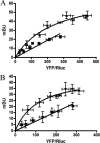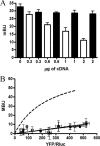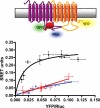Interactions between calmodulin, adenosine A2A, and dopamine D2 receptors
- PMID: 19632986
- PMCID: PMC2788857
- DOI: 10.1074/jbc.M109.034231
Interactions between calmodulin, adenosine A2A, and dopamine D2 receptors
Abstract
The Ca(2+)-binding protein calmodulin (CaM) has been shown to bind directly to cytoplasmic domains of some G protein-coupled receptors, including the dopamine D(2) receptor. CaM binds to the N-terminal portion of the long third intracellular loop of the D(2) receptor, within an Arg-rich epitope that is also involved in the binding to G(i/o) proteins and to the adenosine A(2A) receptor, with the formation of A(2A)-D(2) receptor heteromers. In the present work, by using proteomics and bioluminescence resonance energy transfer (BRET) techniques, we provide evidence for the binding of CaM to the A(2A) receptor. By using BRET and sequential resonance energy transfer techniques, evidence was obtained for CaM-A(2A)-D(2) receptor oligomerization. BRET competition experiments indicated that, in the A(2A)-D(2) receptor heteromer, CaM binds preferentially to a proximal C terminus epitope of the A(2A) receptor. Furthermore, Ca(2+) was found to induce conformational changes in the CaM-A(2A)-D(2) receptor oligomer and to selectively modulate A(2A) and D(2) receptor-mediated MAPK signaling in the A(2A)-D(2) receptor heteromer. These results may have implications for basal ganglia disorders, since A(2A)-D(2) receptor heteromers are being considered as a target for anti-parkinsonian agents.
Figures








Similar articles
-
Calcium-mediated modulation of the quaternary structure and function of adenosine A2A-dopamine D2 receptor heteromers.Curr Opin Pharmacol. 2010 Feb;10(1):67-72. doi: 10.1016/j.coph.2009.10.002. Epub 2009 Nov 10. Curr Opin Pharmacol. 2010. PMID: 19896897 Free PMC article. Review.
-
How calmodulin interacts with the adenosine A(2A) and the dopamine D(2) receptors.J Proteome Res. 2008 Aug;7(8):3428-34. doi: 10.1021/pr8001782. Epub 2008 Jul 1. J Proteome Res. 2008. PMID: 18590318 Free PMC article.
-
Metabotropic glutamate type 5, dopamine D2 and adenosine A2a receptors form higher-order oligomers in living cells.J Neurochem. 2009 Jun;109(5):1497-507. doi: 10.1111/j.1471-4159.2009.06078.x. Epub 2009 Mar 30. J Neurochem. 2009. PMID: 19344374 Free PMC article.
-
Adenosine A2A receptor and dopamine D3 receptor interactions: evidence of functional A2A/D3 heteromeric complexes.Mol Pharmacol. 2005 Feb;67(2):400-7. doi: 10.1124/mol.104.003376. Epub 2004 Nov 11. Mol Pharmacol. 2005. PMID: 15539641
-
Adenosine A2A-dopamine D2 receptor-receptor heteromers. Targets for neuro-psychiatric disorders.Parkinsonism Relat Disord. 2004 Jul;10(5):265-71. doi: 10.1016/j.parkreldis.2004.02.014. Parkinsonism Relat Disord. 2004. PMID: 15196504 Review.
Cited by
-
Post-translational membrane insertion of tail-anchored transmembrane EF-hand Ca2+ sensor calneurons requires the TRC40/Asna1 protein chaperone.J Biol Chem. 2011 Oct 21;286(42):36762-76. doi: 10.1074/jbc.M111.280339. Epub 2011 Aug 30. J Biol Chem. 2011. PMID: 21878631 Free PMC article.
-
Allosteric Interactions between Adenosine A2A and Dopamine D2 Receptors in Heteromeric Complexes: Biochemical and Pharmacological Characteristics, and Opportunities for PET Imaging.Int J Mol Sci. 2021 Feb 9;22(4):1719. doi: 10.3390/ijms22041719. Int J Mol Sci. 2021. PMID: 33572077 Free PMC article. Review.
-
Past, present and future of A(2A) adenosine receptor antagonists in the therapy of Parkinson's disease.Pharmacol Ther. 2011 Dec;132(3):280-99. doi: 10.1016/j.pharmthera.2011.07.004. Epub 2011 Jul 23. Pharmacol Ther. 2011. PMID: 21810444 Free PMC article. Review.
-
Common variants in DRD2 are associated with sleep duration: the CARe consortium.Hum Mol Genet. 2016 Jan 1;25(1):167-79. doi: 10.1093/hmg/ddv434. Epub 2015 Oct 13. Hum Mol Genet. 2016. PMID: 26464489 Free PMC article.
-
Role of Cardiac A2A Receptors Under Normal and Pathophysiological Conditions.Front Pharmacol. 2021 Jan 26;11:627838. doi: 10.3389/fphar.2020.627838. eCollection 2020. Front Pharmacol. 2021. PMID: 33574762 Free PMC article. Review.
References
-
- Agnati L. F., Ferré S., Lluis C., Franco R., Fuxe K. (2003) Pharmacol. Rev. 55, 509–550 - PubMed
-
- Pin J. P., Neubig R., Bouvier M., Devi L., Filizola M., Javitch J. A., Lohse M. J., Milligan G., Palczewski K., Parmentier M., Spedding M. (2007) Pharmacol. Rev. 59, 5–13 - PubMed
-
- Lee S. P., O'Dowd B. F., George S. R. (2003) Life Sci. 74, 173–180 - PubMed
-
- Prinster S. C., Holmqvist T. G., Hall R. A. (2006) J. Pharmacol. Exp. Ther. 318, 974–981 - PubMed
Publication types
MeSH terms
Substances
Grants and funding
LinkOut - more resources
Full Text Sources
Molecular Biology Databases
Miscellaneous

